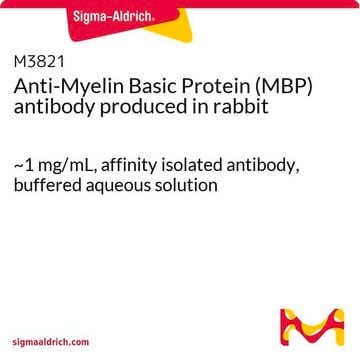06-340
Anti-Myc Antibody
Upstate®, from rabbit
Synonym(s):
Transcription factor p64, avian myelocytomatosis viral oncogene homolog, myc proto-oncogene protein, v-myc avian myelocytomatosis viral oncogene homolog, v-myc myelocytomatosis viral oncogene homolog (avian)
About This Item
Recommended Products
biological source
rabbit
Quality Level
antibody form
affinity isolated antibody
antibody product type
primary antibodies
clone
polyclonal
species reactivity
human, mouse, Xenopus, avian
manufacturer/tradename
Upstate®
technique(s)
ChIP: suitable
immunocytochemistry: suitable
immunoprecipitation (IP): suitable
western blot: suitable
isotype
IgG
NCBI accession no.
UniProt accession no.
shipped in
dry ice
Gene Information
human ... MYC(4609)
General description
Specificity
Immunogen
Application
4 µg of a previous antibody immuno-precipitated Myc as shown by an independent laboratory.
Immunocytochemistry:
This antibody has been used for immunocytochemistry by an independent laboratory. (Ohtsuka, T., 1998)
Epigenetics & Nuclear Function
Transcription Factors
Quality
Western Blot Analysis:
0.5-2 µg/mL of this lot detected Myc in A431 lysates from EGF-stimulated human A431 cells. 0.5-2 µg/mL of a previous lot detected Myc in RIPA lysates from human A431 cells and HeLa nuclear extract.
Target description
Physical form
Storage and Stability
Handling Recommendations:
Upon first thaw, and prior to removing the cap, centrifuge the vial and gently mix the solution. Aliquot into microcentrifuge tubes and store at -20°C. Avoid repeated freeze/thaw cycles, which may damage IgG and affect product performance.
Analysis Note
Positive Antigen Control: Catalog #12-302, EGF-stimulated A431 cell lysate. Add 2.5µL of 2-mercaptoethanol/100µL of lysate and boil for 5 minutes to reduce the preparation. Load 20µg of reduced lysate per lane for minigels.
Other Notes
Legal Information
Disclaimer
Not finding the right product?
Try our Product Selector Tool.
Storage Class Code
12 - Non Combustible Liquids
WGK
WGK 2
Flash Point(F)
Not applicable
Flash Point(C)
Not applicable
Certificates of Analysis (COA)
Search for Certificates of Analysis (COA) by entering the products Lot/Batch Number. Lot and Batch Numbers can be found on a product’s label following the words ‘Lot’ or ‘Batch’.
Already Own This Product?
Find documentation for the products that you have recently purchased in the Document Library.
Customers Also Viewed
Our team of scientists has experience in all areas of research including Life Science, Material Science, Chemical Synthesis, Chromatography, Analytical and many others.
Contact Technical Service














